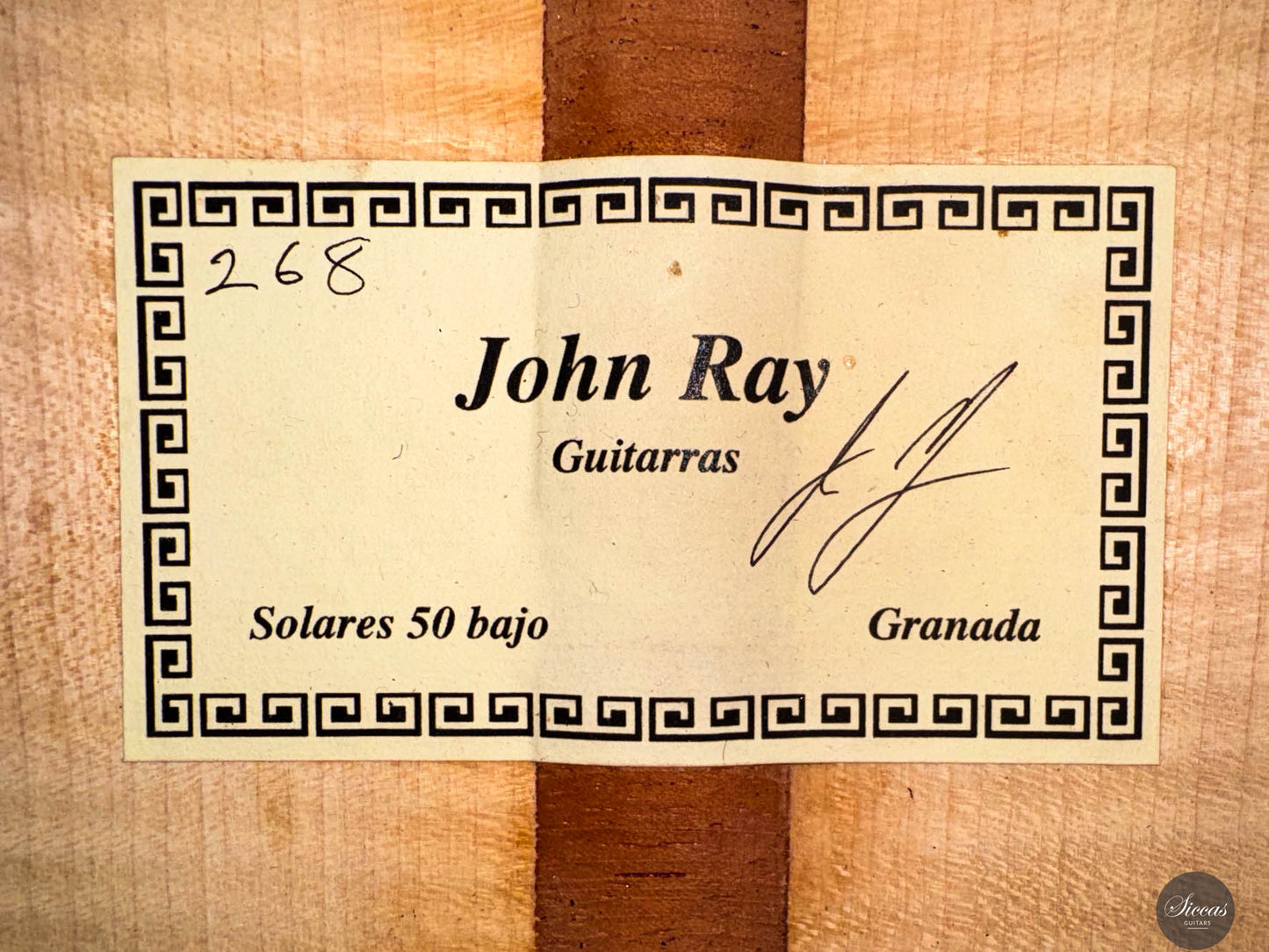John Ray - 2023 - Torres No.268
John Ray - 2023 - Torres No.268
Details
Details
Overview
Overview
Shipping important note
Shipping important note
Delivery times are typically reliable and most instruments arrive within the estimated timeframe.
Should any unexpected delay occur, our team will keep you informed and provide support at every step. For all shipping details and exceptions, please see our Shipping Policy.
Details about GPSR
Details about GPSR

























Video overview



More details about the guitar
About the luthier
John Ray, originally from Canada, moved to Granada in 1989 to immerse himself in the art of guitar making. His passion for craftsmanship led him to learn from many renowned local luthiers, with a particularly strong influence from German guitar maker Rolf Eichinger, who had also relocated to Granada to dedicate himself to building guitars. Over the years, John developed his skills further through the restoration of masterpieces by legendary makers such as Miguel Rodriguez, Vicente Arias, Manuel Ramirez, and Salvador Ibañez. Today, John Ray’s guitars are highly regarded by professional guitarists for their outstanding quality and authentic Spanish character.About the guitar
This exquisite instrument is a faithful replica of the renowned 1892 Antonio de Torres SE 153. John Ray first encountered the original SE 153 during a concert by Carles Trepat in Spain. Captivated by its beauty and tone, John had the opportunity to examine the guitar up close after the concert, which ignited his ambition to create an authentic replica. The following year, he met Trepat again to take precise measurements and photographs of the Torres masterpiece, allowing him to begin the meticulous process of crafting his own interpretation of the SE 153. The result is a guitar that not only closely mirrors the aesthetic elegance of the original but also honors its playability and tonal excellence. The top is made from high-quality spruce, while the back and sides are crafted from maple, providing a warm, mellow sound with exceptionally round and resonant low mids. Every detail reflects Ray’s dedication to authenticity, from the traditional French polish finish to the finely crafted tuners made by Claus Scheller. Although the guitar is used, it is in mint condition showing the care of the previous owner.Regular care extends the life of the instrument
Even with careful use, a classical guitar may gradually change in appearance or respond to unstable storage conditions. Have a close look at your guitar regularly and be attentif to changes. If your instrument is suffering from its environement, it will let you know.
Protect Your Guitar: Handle with Care
Be mindful when touching your instrument with greasy or unwashed hands: any skin contact is a small attack on the varnish. Of course, a guitar is made to be played, but taking a few precautions helps preserve its beauty: wash your hands before playing, wear long sleeves, and avoid unnecessary direct skin contact with the body of the instrument.
Pro tip: Avoid playing with a button-up shirt, heavy jewelry, or a belt, as these can scratch the guitar. Also, make sure your guitar case is free of any objects that could damage the instrument during storage.
String care
A good habit to adopt is wiping down your strings briefly after each playing session. This small action significantly extends their lifespan and helps maintain a consistent, comfortable feel under your fingers.
Most importantly, clean strings are essential for keeping your instrument in tune. Corrosion, sweat, and dust can affect the uniformity of the strings and interfere with accurate tuning across the entire fingerboard.
Pro tip: If you're having trouble getting your guitar in tune, it might be time to change the strings. A useful test is to compare the pitch of the 12th fret harmonic with the fretted note at the 12th fret; if there's an unusually large gap between them, your strings may have lost their integrity and should be replaced.
Keep Your Shellac Finish Shining!
Got a guitar with a shellac (French polish) finish? Here's a simple trick: Take a clean microfiber cloth and gently breathe on the surface to create a light mist. Then, softly rub to remove fingerprints, sweat, and grease. That’s usually all it takes to keep it looking great, no products needed!
Pro tip: Every few years, treat your guitar to a check-up with a luthier to keep it in top shape.
Storing Your Guitar: Climate Matters
Your guitar can safely stay outside its case, as long as the surrounding environment maintains 42–55% humidity and a temperature between 18–25°C.
Keep in mind that humidity levels can still fluctuate inside the case, especially during seasonal changes.
- Too much humidity may cause overtightened strings and a dull tone.
- Too little humidity can lead to a bulging top, string buzz, or even cracks.
Avoid placing your guitar near radiators, air conditioners, or windows with direct sunlight.
Pro tip: Always close your guitar case while playing. This helps preserve a stable microclimate inside the case, so your instrument is protected the moment you put it back in.






















































